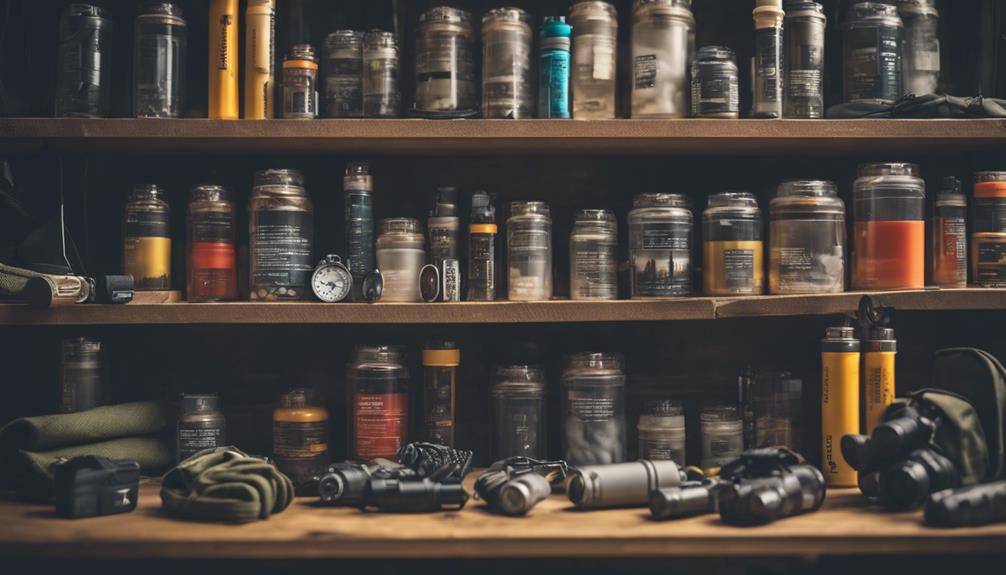To effectively weatherproof your shelter, start by choosing a stable, elevated location away from hazards like floods and falling branches. Gather sturdy materials, such as branches and insulation like leaves or grass. Construct a solid frame, ensuring it's securely tied to withstand harsh weather. Use waterproofing sprays on manufactured structures or create natural barriers with bricks and bitumen. Regularly inspect for leaks and maintain insulation to keep heat in and moisture out. Remember to assess your entire structure's integrity frequently. With these strategies, you can greatly enhance your shelter's protection and durability against the elements, fostering a safer outdoor experience.
Key Takeaways
- Use waterproofing sprays on manufactured shelters and focus on seam lines to prevent water leaks.
- Apply natural insulation methods like leaves, grass, and moss to minimize heat loss effectively.
- Construct a solid foundation and regularly inspect for structural integrity to withstand weather conditions.
- Enhance waterproof barriers by layering leaves and using spruce branches for added wind and rain protection.
- Conduct routine cleaning and disinfecting to maintain hygiene and prevent moisture-related issues.
Choosing the Right Location

When you're choosing the right location for your shelter, you want to zero in on a spot that offers stability and safety. Start by finding level ground to guarantee your shelter remains sturdy. Steer clear of areas prone to flash floods or landslides, and definitely avoid spots beneath dead trees or branches that could fall. Take a moment to check for signs of wildlife habitats or trails, since you'll want to avoid potential threats.
Next, evaluate wind and weather patterns. Consider the prevailing wind direction and position your shelter's entrance accordingly. Look for natural windbreaks like trees or rocks and avoid low-lying areas where cold air settles. Good drainage is essential, so choose a spot that allows for water runoff without pooling. Additionally, ensure that your site is located with accessibility to essential resources like water and firewood without compromising safety.
Also, think about accessibility and visibility. Opt for a location that's easy to reach in emergencies, and one that's visible from a distance for easier rescue. Guarantee the area is clear of dense underbrush, and select a spot near a natural water source but far enough away to avoid flooding. These factors will help you create a safe and comfortable environment.
Gathering Necessary Materials

To build a sturdy shelter, you'll need to gather essential materials that provide both structure and insulation. Start with long, sturdy branches or logs for the frame. Look for wrist-thick logs to create load-bearing structures, and collect smaller branches or sticks for additional support. If you're crafting a debris hut, strong, long branches will be invaluable.
For insulation, gather leaves, grass, moss, or bark to help keep the cold out and maintain warmth. Pine needles can also serve as an effective alternative. In colder conditions, snow can act as temporary insulation. You might want to create a leaf bed using dry leaves, grass, and soft vegetation to elevate yourself off the ground. Familiarity with local flora and fauna aids in selecting the best materials for your shelter.
Securing your materials is essential. Bring along cordage like paracord or natural vines to tie your frame together. Don't forget cutting tools like a knife or hatchet to trim branches to the right lengths. If you're aiming for a more durable shelter, consider galvanized steel or aluminum for the frame. With the right materials gathered, you'll be well on your way to constructing a weatherproof sanctuary.
Frame Construction Techniques

Crafting a reliable frame is essential for guaranteeing your shelter can withstand the elements. For an A-frame shelter, gather large, sturdy branches or logs. Lean these branches against a central ridgepole, forming the A-frame structure. Secure everything with cordage like paracord or bank line, and stabilize the frame by using natural forks in trees or lashing the tops of branches together. This guarantees your frame can support extra layers for insulation and waterproofing.
If you prefer a lean-to shelter, find a long, sturdy branch and lean it against a solid support, such as a tree or large rock. Prop it at an angle and lean smaller branches against it at a 45-degree angle. Cover this frame with leaves, ferns, or branches to create a waterproof layer, securing the structure with cordage if available. Short-term shelters are often beneficial as they can be built quickly, ensuring immediate protection from the elements.
For a tarp shelter, locate two trees spaced about 8-10 feet apart. Tie cordage between them at chest height to create a ridgeline, draping the tarp over it. Secure the tarp's corners to the ground with stakes or heavy objects, and adjust the tension to guarantee it sheds water effectively.
Insulation Methods

Insulation is key to keeping your shelter warm and comfortable in harsh weather. Using natural materials effectively can provide the protection you need. Here are some methods to take into account:
| Material Type | Benefits |
|---|---|
| Leaves and Pine Needles | Easy to gather; effective at trapping air. |
| Grass and Straw | Lightweight; excellent insulation properties. |
| Bark and Wood Chips | Durable; provides wind protection. |
| Cattail Down | Great insulation; ideal for thick layering. |
For structural techniques, contemplate double-wall construction, which creates an air gap for better insulation. Ground insulation is also crucial, as it prevents heat loss to the ground. Aim for a thickness of 1-2 feet of insulating material to maintain warmth. Additionally, proper insulation is essential for wilderness survival, as it can significantly impact your ability to stay warm and dry.
Avoid common mistakes, like using wet materials or neglecting to insulate the ground. Regularly check for gaps and add insulation as needed to guarantee your shelter remains cozy and effective against the elements. By mastering these insulation methods, you'll greatly enhance your shelter's comfort and safety during harsh weather conditions.
Waterproofing Strategies

Waterproofing is essential for ensuring your shelter remains dry and functional during inclement weather. Before the season starts, apply a waterproofing spray to your manufactured shelter. Pick a dry day for this task, so the spray dries properly. Set up your shelter in the backyard or lay it flat, ensuring an even application. Don't forget to pay extra attention to seam lines and areas where water might collect. Allow the shelter to dry completely before packing it away to avoid fabric sticking and damage. Quality shelters generally perform well out of the box, but personal assurance through waterproofing enhances shelter reliability.
For traditional structured areas, consider mixing flat bricks with cement to create a dense slurry. You can also use a lime molasses mixture on a concrete base, followed by curing and regular watering. If you have time, try applying a waterproofing solution made from clay and bhusa sand, plastered with cow dung and mud.
Modern methods include using bitumen as a protective layer, along with hydrophobic liquids fortified with glass. Before applying these materials, repair any cracks or weakened areas. Enhance adhesion by applying a primer first, and reinforce the base coat with fibreglass mesh for added strength.
Creating a Safe Sleeping Area

To guarantee your baby sleeps safely, it's crucial to create a secure sleeping area that meets specific guidelines. Start by ensuring the sleeping surface is firm, flat, and level. Here are five key points to remember:
- Use a safety-approved mattress in a cot, bassinet, or co-sleeper that fits tightly without gaps.
- Always place your baby on their back for every sleep, including naps, to reduce the risk of SIDS.
- Keep the sleep space clear of soft items like pillows, toys, or mattress padding that could obstruct breathing.
- Position the crib in your bedroom for the first six months, away from cords and smoke; this ensures a smoke and vapour-free environment.
- Regularly inspect the crib or bassinet for loose parts or damage.
Building a Fire Pit

When you're building a fire pit, choosing the right location is essential for safety and efficiency. You'll want to take into account factors like distance from flammable structures and accessibility for maintenance. Additionally, be sure to consider that a DIY fire pit can be built for less than store-bought options, which adds to its appeal. Let's explore some tips to guarantee your fire pit is both functional and safe.
Fire Pit Location Tips
Carefully choosing the location of your fire pit is essential for safety and enjoyment. Follow these tips to guarantee you pick the right spot:
- Distance from Structures: Keep your fire pit at least 10 feet away from homes, garages, and fences. Check local regulations, as some areas require distances up to 25 feet.
- Stable Surface: Place your fire pit on a non-flammable surface like stone, concrete, or brick. Avoid grassy or wooden areas to prevent tipping. Regular inspections of the fire pit can also ensure ongoing safety and stability in its location.
- Overhead Clearance: Guarantee at least 10 feet of overhead clearance above the flames. Avoid placing it under covered patios or low-hanging branches.
- Wind Considerations: Observe prevailing wind patterns. Position the fire pit where smoke won't blow toward your home or neighbors, and avoid using it on windy days.
- Ground Leveling: Make certain the ground is level. Use sand or gravel if needed to create a stable base.
Safety and Maintenance Practices
After selecting the right location for your fire pit, focusing on safety and maintenance practices becomes vital. Keep children, pets, and flammable objects at a safe distance. Never leave a burning fire pit unattended; assign a responsible person to supervise. Avoid loose-fitting clothing that could easily catch fire, and always use fire-resistant gloves and a poker to manage the flames safely. Make certain everyone understands fire safety rules to prevent accidents.
When it comes to fuel, only use the types specified by the manufacturer, such as seasoned wood or propane. Never use accelerants like gasoline, as they can cause dangerous flare-ups. Start your fires with kindling, and control the size to prevent overloading the pit. Additionally, be sure to monitor weather conditions as wind can quickly change the fire's behavior.
Emergency preparedness is essential. Keep essential tools like a fire extinguisher, water, and a shovel nearby. Always douse the flames thoroughly before leaving and confirm ashes are completely cool. Perform routine maintenance checks on your fire pit, following the manufacturer's instructions and checking local regulations. Finally, use spark screens to prevent embers from escaping and confirm your fire pit sits on a stable, fire-resistant surface.
Final Shelter Inspection

Before settling in, you need to conduct a thorough final inspection of your shelter. Check the structural integrity to verify it can withstand the elements, assess for any gaps in insulation, and evaluate the effectiveness of your waterproofing. This step is essential to guarantee your safety and comfort in the wild. Additionally, ensuring proper waterproofing can significantly enhance the durability of your shelter against harsh weather conditions.
Structural Integrity Check
When conducting a structural integrity check during the final shelter inspection, it is essential to thoroughly assess both the visible and hidden elements of the building. This guarantees that the shelter is safe, functional, and ready for use. Start by focusing on these key areas:
- Check for visible structural defects like loose connections and leaks.
- Verify essential facilities, such as running water and power, are in good working condition.
- Conduct a thorough vulnerability analysis of the entire structure.
- Look for signs of wear and tear, including cracks or corrosion.
- Assess the site for accessibility, confirming it's safe from environmental hazards.
After identifying any issues, prioritize maintenance needs and gather cost estimates for necessary repairs. Don't forget to confirm compliance with local regulations, as this is critical for safety. Regular inspections by relevant authorities are important, so keep records of any unsafe conditions and the corrective actions taken. By performing a diligent structural integrity check, you'll not only weatherproof your shelter but also provide a secure haven for all who rely on it. Additionally, be aware of state-specific inspection requirements to ensure that your shelter meets local safety standards.
Insulation Gaps Assessment
Insulation gaps can greatly impact your shelter's overall energy efficiency and comfort. When evaluating these gaps, focus on the walls and roofs, as they play an essential role in maintaining thermal balance. Proper insulation reduces heat gain in hot climates and heat loss in cold ones, guaranteeing your shelter stays comfortable year-round.
Start by inspecting all areas where insulation material meets structural elements. Look for cracks, holes, or any areas where the insulation isn't snug. Even small gaps can lead to significant energy losses, so be thorough. Remember, thermal mass—like water barrels—can enhance insulation effectiveness, so consider integrating these elements into your design. Additionally, utilizing response monitoring tools can help track the effectiveness of your insulation efforts over time.
Don't forget about natural ventilation, which complements insulation by helping regulate indoor temperatures. Confirm your openings are at least 5% of the facade area with a height difference of 1 meter to promote adequate airflow. Analyze how wind patterns around your shelter affect ventilation too.
Waterproofing Effectiveness Evaluation
Evaluating the waterproofing effectiveness of your shelter is essential for guaranteeing long-term protection against water infiltration and damage. During your final inspection, focus on several key aspects to determine if your waterproofing efforts are successful.
- Water Tightness: Check for any signs of leaks or moisture penetration.
- Durability: Guarantee the materials can withstand mechanical and chemical stresses.
- Crack Resistance: Inspect for cracks that could compromise your shelter's integrity.
- UV Resistance: Confirm that the materials won't degrade from sunlight exposure.
- Early Age Performance: Look for any changes in absorption rates after initial curing. Additionally, ensure that the materials exhibit good elasticity to accommodate structural movements without compromising waterproofing.
Utilize testing methods like the Waterproofing Test (NBR 15575-3) and Immersion Absorption (NBR 9778) to gain insights into your shelter's performance. Pay attention to behavioral changes after wetting and drying cycles, as increased absorption can indicate a need for repairs. By conducting a thorough evaluation, you can guarantee that your shelter remains a reliable barrier against the elements, providing you with peace of mind for years to come.
Enhancing Shelter Protection

Enhancing shelter protection is crucial for staying safe and comfortable in unpredictable weather conditions. You can employ various natural materials and techniques to bolster your shelter's defenses. Start by layering leaves to create a waterproof barrier, and use spruce branches to block wind and rain. Moss can act as a windblock in lower areas, while reeds can thatch your shelter, although they require time and effort. Additionally, using a well-chosen site for your shelter can significantly improve its overall effectiveness against the elements.
Incorporating tarps and synthetic materials greatly enhances your protection. Drape a tarp over an A-frame for instant coverage, and consider using an emergency blanket for added warmth. Building techniques like creating a rectangular frame filled with debris or adding a debris wall to a Lean-To can provide insulation and stability.
Site selection also plays a crucial role. Choose an elevated area away from hazards, and orient your shelter to shield against prevailing winds. Here's a quick overview:
| Natural Materials | Synthetic Materials | Building Techniques |
|---|---|---|
| Leaves for waterproofing | Tarps for instant coverage | Rectangular frames for stability |
| Spruce branches for insulation | Emergency blankets for warmth | Debris walls for wind protection |
| Moss as windblock | Waterproof ground cloth | Small entrance for heat retention |
| Reeds for thatching | Using local materials | Ridgepole for structure
Maintaining Your Shelter

To keep your shelter in top shape, regular inspections and repairs are essential. You need to make seasonal adjustments to address any wear and tear that comes with changing weather. Plus, don't forget to clean and remove debris to maintain a safe and healthy environment. Regularly checking for rust and corrosion is also a crucial part of maintaining structural integrity.
Regular Inspections and Repairs
Regular inspections and repairs are essential for maintaining the integrity and comfort of your shelter. By regularly checking various components, you can identify issues before they become major problems. Here's what you should focus on during your inspections:
- Structural Integrity: Look for sagging branches or weakened load-bearing structures. Replace any damaged parts to guarantee stability.
- Weatherproofing Layers: Check the waterproof material for gaps and seal them with leaves or bark. Make sure the roof is still watertight.
- Entrance and Ventilation: Inspect the entrance flap for damage and confirm it seals properly to keep out the elements. Verify ventilation openings are clear for airflow.
- Ground and Bedding: Examine your raised bed for moisture and pests. Clean it out and add insulating materials as needed for warmth.
- Foundation Stability: Verify your shelter's foundation isn't eroded and remains stable. Reinforce weak points with extra support if necessary.
Additionally, incorporating multi-functional gear into your shelter can enhance your ability to adapt to various weather conditions.
Seasonal Adjustments Needed
After ensuring your shelter is structurally sound and weatherproof, it's time to adapt it for the changing seasons. Focus on gathering dry materials to maximize insulation effectiveness. Wet or damp materials will only lead to heat loss and hypothermia, so dry them out if possible before use. Natural materials like leaves, pine needles, and grass work well for insulation, ensuring they're as dry as possible. Additionally, ensure that your shelter has adequate waterproofing to protect against moisture and potential damage.
Next, consider wind protection. Orient your shelter away from prevailing winds and add layers of wood, leaves, or pine needles for added defense. A double-wall construction can greatly enhance wind protection, while securing the shelter with cordage techniques using vines, grass, or bark can help keep it stable. Don't forget to add a waterproof layer to the roof to prevent leaks.
Cleaning and Debris Removal
Keeping your shelter clean and free of debris is vital for maintaining a healthy environment. Regular cleaning not only improves hygiene but also creates a more comfortable space for the animals. Here are some steps you should take:
- Remove all feed, feces, and bedding from the enclosure.
- Clean feed and water containers separately.
- Use rubber squeegees to minimize dust clouds during cleaning.
- Lower litter trays deep into the trash to reduce the spread of organic material.
- Scoop feces and sweep up spilled litter or kibble promptly.
After debris removal, it's important to clean surfaces with a detergent. Apply the solution thoroughly, let it soak, and scrub stubborn areas. Don't skip the disinfection process; use an EPA-approved disinfectant and make sure surfaces remain wet for at least 10 minutes. Additionally, remember that effective washing can eliminate up to 99% of bacteria, significantly enhancing the sanitation of your shelter. Finally, allow surfaces to air dry completely before returning animals to prevent skin issues.
Frequently Asked Questions
How Can I Determine if My Shelter Is Stable Enough?
To determine if your shelter's stable enough, start by evaluating the materials used in construction. Check for any signs of wear or damage, and assess how well the structure holds up against local conditions. You should also examine the foundation and walls for cracks or shifting. If you notice any issues, consult a professional to verify it's safe. Don't forget to keep an eye on any modifications made by occupants that could affect stability.
What Should I Do if It Starts to Rain Unexpectedly?
If it starts to rain unexpectedly, quickly assess your shelter's waterproofing. Add more insulating materials like leaves or grass to the roof and sides to improve coverage. If you have a tarp, drape it over the structure for extra protection. Check for leaks and reinforce any weak spots. Create a drainage system by digging small trenches around the shelter to redirect water away and keep your space dry and comfortable. Stay alert and adaptable!
Can I Use Tarps or Blankets for Insulation?
Yes, you can definitely use tarps or blankets for insulation. Tarps provide a solid barrier against wind and rain, while blankets can offer thermal insulation when wrapped around your body or used in a shelter. To enhance insulation further, combine them with natural materials like leaves or moss. These layers can trap heat and keep you warmer. Just make certain they're secured properly to create a stable and effective shelter.
How Do I Prevent Condensation Inside the Shelter?
To prevent condensation inside your shelter, guarantee proper ventilation. Create a small fire pit that allows smoke to escape, and leave a gap at the top for air circulation. Use natural materials like woven branches to enhance airflow, but avoid sealing everything too tightly. Insulate with dry materials to prevent moisture buildup, and keep the ground insulated as well. Regularly check the insulation to maintain a dry, comfortable environment.
What Are Some Signs of Structural Weakness to Look For?
If your shelter's starting to look like it's been through a tornado, you've got to pay attention! Look for damp spots, mold, and peeling paint; they scream trouble. Sagging ceilings and cracks in walls are like alarm bells. If doors stick or windows refuse to budge, your foundation might be shifting. Keep an eye on that roof—missing shingles or pooling water can spell disaster. Regular checks are your best defense against structural weakness!
Conclusion
By mastering these essential skills, you’ll be well-equipped to weatherproof your shelter and protect yourself from the elements. Remember, a solid foundation and proper insulation can make all the difference. Why risk your safety when you can take proactive steps to guarantee your comfort? Stay vigilant in maintaining your shelter and regularly check for any vulnerabilities. With the right techniques and materials, you can create a safe haven that stands strong against nature’s challenges. For additional assistance in fortifying your shelter, consider researching shelter building tips from reliable sources. Learning from experienced outdoor enthusiasts or survival experts can provide valuable insights and techniques to improve your shelter’s resilience. Take the time to implement these tips and continually assess your shelter’s condition to ensure it remains secure and protective. With dedication and knowledge, you can confidently face any weather-related obstacles knowing your shelter is well-prepared.










